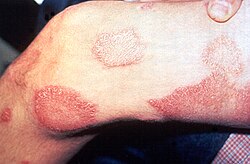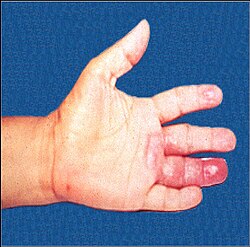Leprosy (pathology)
Definition[edit | edit source]
Leprosy is a granulomatous inflammatory disease caused by Mycobacterium leprae (Hansen's bacillus). A person becomes infected from an infected person through the air or by contact through broken skin (long-term close contact is usually necessary), transplacental or breast milk transmission is possible from mother to child. The incubation period is usually 2-3 years, sometimes more. A common complication of leprosy is secondary (AA) amyloidosis.
Etiology[edit | edit source]
The etiological agent is Mycobacterium leprae, which is not toxic to the host's cells, has an affinity for peripheral nerves and occurs mainly in cooler parts of the body (skin, nose, fingers, peripheral lymph nodes and nerves, testicles).
Forms[edit | edit source]
- Lepromatous - in people with low resistance, lepromas (granulomas from leprosy cells) form, the affected person is infectious, the course does not last longer than 10 years.
- Tuberculoid - in people with high resistance, the formation of tuberculoid nodules (similar to tubercles in tuberculosis - they do not contain leprosy cells), the affected person is not infectious, protracted course (over 20 years).
Leprosy lepromatosa[edit | edit source]
It causes nodular deposits (lepromas) or diffuse infiltrates, which microscopically form modified histiocytes, so-called leprosy cells (bulky, weakly eosinophilic cytoplasma containing bacteria), some of them are large, often multinucleated and contain vacuoles with spherical clusters of bacteria (globi) - Virchow cells. The nodules can ulcerate – the resulting ulcers are full of Hansen's bacilli and are highly infectious, they can also scar.
The disease begins with fevers and skin involvement - a macular rash that turns into spotted hyperpigmentation, lepromas form in the skin of the face (facies leontina), limbs and buttocks and the nerves are affected (infiltrated by leprosy cells - the skin over the lepromas is insensitive, trophic changes and ulcers on the fingers and toes with the formation of deformities up to the loss of finger joints), at the same time, lepromas form on the nasal mucosa (nasal secretions contain a large amount of mycobacteria and are considered the main source of infection transmission), internal organs are affected during hematogenous dissemination ( miliary lepromas, transformation of reticuloendothelium in leprous cells) – especially liver, spleen, nodes, adrenal glands, testicles (atrophy and sterility).
Leprosy tuberculoides[edit | edit source]
Nodules are formed from epithelioid and Langhans cells (leprosy cells and mycobacteria are not present – patients with this form of leprosy are not infectious), there is a small lymphoplasmacytic infiltration on the periphery, central caseification is exceptional.
Typical is the formation of a leprous macule (a pale area of skin bordered by a slightly raised and hardened edge, its base is tuberculoid nodules, the entire area of skin is numb) and the simultaneous involvement of peripheral nerves (small skin nerves and later superficial nerves (e.g. on the wrist) - initially penetrated by tuberculoid nodules, later they may scar or succumb to caseification and colliculation - a painful nerve abscess is formed, which may burst outward), trophic changes and disfigurement of the hands and feet are similar to the lepromatous form, in addition muscle atrophy occurs.
Links[edit | edit source]
Related Articles[edit | edit source]
Source[edit | edit source]
- PASTOR, Jan. Langenbeck's medical web page [online]. ©2006. [cit. 2012-01-22]. <https://langenbeck.webs.com/>.


